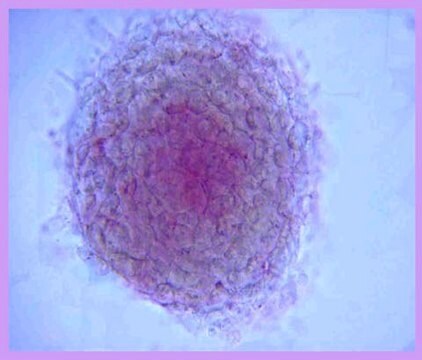SCR066
Quantitative Alkaline Phosphatase ES Characterization Kit
This Quantitative Alkaline Phosphatase Embryonic Stem (ES) Characterization Kit easily quantifies the amount of alkaline phosphatase present within their embryonic stem cell cultures using a convenient 96-well colorimetric enzymatic assay.
About This Item
Recommended Products
Quality Level
species reactivity (predicted by homology)
mammals
manufacturer/tradename
Chemicon®
technique(s)
cell culture | stem cell: suitable
input
sample type: human embryonic stem cell(s)
sample type cardiac stem cell(s)
sample type neural stem cell(s)
sample type hematopoietic stem cell(s)
sample type epithelial cells
sample type mesenchymal stem cell(s)
sample type pancreatic stem cell(s)
sample type: mouse embryonic stem cell(s)
sample type induced pluripotent stem cell(s)
General description
Alkaline phosphatase (ALP) is a hydrolase enzyme responsible for dephosphorylating molecules such as nucleotides, proteins, and alkaloids under alkaline conditions. The enzyme is present within all tissues of the body but is elevated in cells of the liver, kidney, bone, placenta, embryo and under specific disease states. Under alkaline conditions (pH>10), ALP can catalyze the hydrolysis of p-nitrophenylphosphate (p-NPP) into phosphate and p-nitrophenol, a yellow colored by-product of the catalytic reaction. The amount of p-nitrophenol produced is proportional to the amount of alkaline phosphatase present within the reaction. The amount of ALP can thus be reliably quantified by reading the amount of p-nitrophenol amassed after the catalytic reaction at 405 nm on a spectrophotometer.
Application
Stem Cell Research
Components
p-NPP Buffer: (Part No. ES011-10ML) 10 mL
Reaction Stop Solution: (Part No.CS200653) 5 mL
1X Wash Solution: (Part No. CS200652) 2 X 125 mL
Recombinant Alkaline Phosphatase Standard: (Part No. CS200654) 0.5 μg (10 μg/mL)
Storage and Stability
Legal Information
Disclaimer
Signal Word
Danger
Hazard Statements
Precautionary Statements
Hazard Classifications
Aquatic Chronic 3 - Eye Dam. 1 - Met. Corr. 1 - Repr. 2 - Skin Corr. 1B
Storage Class Code
8A - Combustible corrosive hazardous materials
Regulatory Listings
Regulatory Listings are mainly provided for chemical products. Only limited information can be provided here for non-chemical products. No entry means none of the components are listed. It is the user’s obligation to ensure the safe and legal use of the product.
JAN Code
SCR066:
Certificates of Analysis (COA)
Search for Certificates of Analysis (COA) by entering the products Lot/Batch Number. Lot and Batch Numbers can be found on a product’s label following the words ‘Lot’ or ‘Batch’.
Already Own This Product?
Find documentation for the products that you have recently purchased in the Document Library.
Our team of scientists has experience in all areas of research including Life Science, Material Science, Chemical Synthesis, Chromatography, Analytical and many others.
Contact Technical Service









